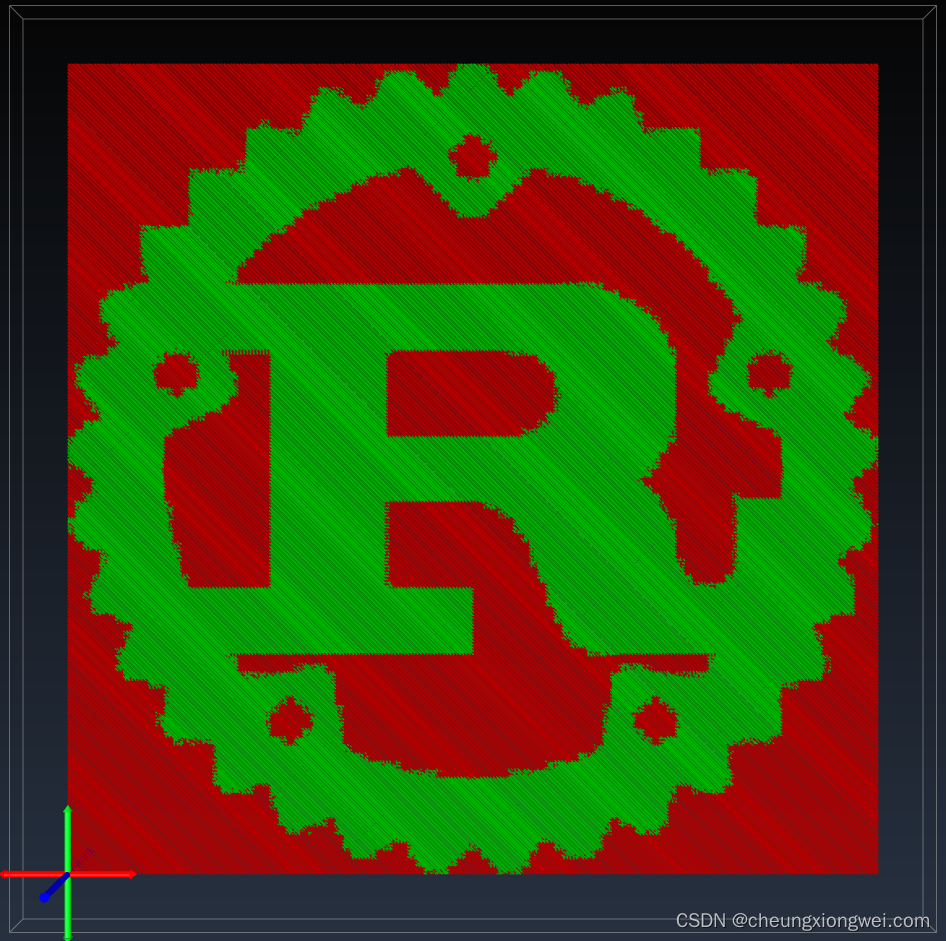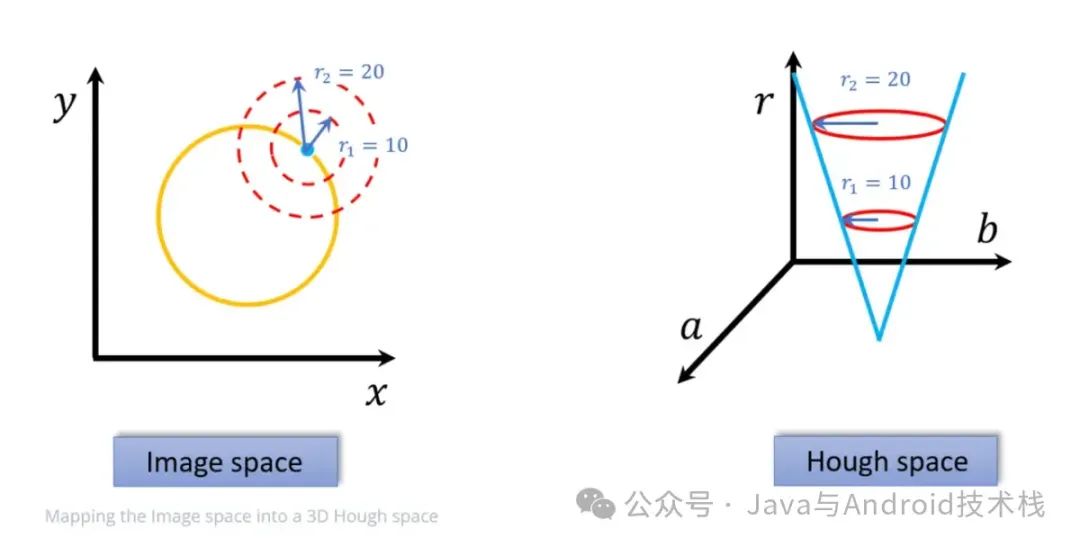系列文章
- ⭐深入理解G0和G1指令:C++中的实现与激光雕刻应用
- ⭐基于二值化图像转GCode的单向扫描实现
- ⭐基于二值化图像转GCode的双向扫描实现
- ⭐基于二值化图像转GCode的斜向扫描实现
- ⭐基于二值化图像转GCode的螺旋扫描实现
- ⭐基于OpenCV灰度图像转GCode的单向扫描实现
- ⭐基于OpenCV灰度图像转GCode的双向扫描实现
- ⭐基于OpenCV灰度图像转GCode的斜向扫描实现
- ⭐基于OpenCV灰度图像转GCode的螺旋扫描实现
⭐**系列文章GitHub仓库地址**
基于OpenCV灰度图像转GCode的单向扫描实现
本文将介绍如何使用OpenCV库将灰度图转换为GCode,并通过单向扫描实现对图像的激光雕刻。GCode是一种用于控制数控机床和3D打印机的指令语言,而OpenCV是一种开源计算机视觉库。通过结合这两者,我们可以实现从图像到GCode的转换,进而在机器上实现图像的物理输出。
引言
在数字制造时代,将图像转换为GCode是实现自动化加工和打印的关键步骤。本文将探讨如何利用OpenCV库将灰度图转换为GCode,并通过单向扫描的方式实现对图像的激光雕刻。

上图是未做任何处理,直接从灰度图转换成GCode。

优化后生成的GCode如上所示:

原始图像如上所示:
单向扫描存在的问题
单向操作存在来回折返空行程问题,导致加工时间变长。
本文主要通过使用以下形式的代码,删除了多余的行程(空跑没任何意义的G0)。
while(++x < image.cols && image.at<std::uint8_t>(y, x) == 255) {
length++;
}
--x;
实现了未优化版本和优化版本的单向扫描,两者加工时间从生成的GCode代码上,可以看出有了很大差异。
红色是 G0,绿色是加工部分 G1。
当然如果使用双向扫描方向,加工时间差异会更大。
灰度图像单向扫描代码示例
编译器要求最低 C++23
#pragma once
#include <opencv2/opencv.hpp>
#include <fstream>
#include <print>
#include <vector>
#include <optional>
#include <ranges>
struct G0 {
std::optional<float> x, y;
std::optional<int> s;
std::string toString() {
std::string command = "G0";
if(x.has_value()) {
command += std::format(" X{:.3f}", x.value());
}
if(y.has_value()) {
command += std::format(" Y{:.3f}", y.value());
}
if(s.has_value()) {
command += std::format(" S{:d}", s.value());
}
return command;
}
explicit operator std::string() const {
std::string command = "G0";
if(x.has_value()) {
command += std::format(" X{:.3f}", x.value());
}
if(y.has_value()) {
command += std::format(" Y{:.3f}", y.value());
}
if(s.has_value()) {
command += std::format(" S{:d}", s.value());
}
return command;
}
};
struct G1 {
std::optional<float> x, y;
std::optional<int> s;
std::string toString() {
std::string command = "G1";
if(x.has_value()) {
command += std::format(" X{:.3f}", x.value());
}
if(y.has_value()) {
command += std::format(" Y{:.3f}", y.value());
}
if(s.has_value()) {
command += std::format(" S{:d}", s.value());
}
return command;
}
explicit operator std::string() const {
std::string command = "G1";
if(x.has_value()) {
command += std::format(" X{:.3f}", x.value());
}
if(y.has_value()) {
command += std::format(" Y{:.3f}", y.value());
}
if(s.has_value()) {
command += std::format(" S{:d}", s.value());
}
return command;
}
};
class ImageToGCode
{
public:
// 激光模式
enum class LaserMode {
Cutting, // 切割 M3 Constant Power
Engraving, // 雕刻 M4 Dynamic Power
};
// 扫描方式
enum class ScanMode {
Unidirection, // 单向
Bidirection, // 双向
};
struct kEnumToStringLaserMode {
constexpr std::string_view operator[](const LaserMode mode) const noexcept {
switch(mode) {
case LaserMode::Cutting: return "M3";
case LaserMode::Engraving: return "M4";
}
return {};
}
constexpr LaserMode operator[](const std::string_view mode) const noexcept {
if(mode.compare("M3")) {
return LaserMode::Cutting;
}
if(mode.compare("M4")) {
return LaserMode::Engraving;
}
return {};
}
};
ImageToGCode() = default;
~ImageToGCode() = default;
auto &setInputImage(const cv::Mat &mat) {
this->mat = mat;
return *this;
}
auto &setOutputTragetSize(double width, double height, double resolution = 10.0 /* lin/mm */) {
this->width = width;
this->height = height;
this->resolution = resolution;
return *this;
}
auto &builder() {
command.clear();
try {
matToGCode();
} catch(cv::Exception &e) {
std::println("cv Exception {}", e.what());
}
std::vector<std::string> header;
header.emplace_back("G17G21G90G54"); // XY平面;单位毫米;绝对坐标模式;选择G54坐标系
header.emplace_back(std::format("F{:d}", 30000)); // 移动速度 毫米/每分钟
header.emplace_back(std::format("G0 X{:.3f} Y{:.3f}", 0.f, 0.f)); // 设置工作起点及偏移
header.emplace_back(std::format("{} S0", kEnumToStringLaserMode()[laserMode])); // 激光模式
if(airPump.has_value()) {
header.emplace_back(std::format("M16 S{:d}", 300)); // 打开气泵
}
std::vector<std::string> footer;
footer.emplace_back("M5");
if(airPump.has_value()) {
footer.emplace_back("M9"); // 关闭气泵,保持 S300 功率
}
command.insert_range(command.begin(), header);
command.append_range(footer);
return *this;
}
bool exportGCode(const std::string &fileName) {
std::fstream file;
file.open(fileName, std::ios_base::out | std::ios_base::trunc);
if(!file.is_open()) {
return false;
}
for(auto &&v: command | std::views::transform([](auto item) { return item += "n"; })) {
file.write(v.c_str(), v.length());
}
return true;
}
auto setLaserMode(LaserMode mode) {
laserMode = mode;
return *this;
}
auto setScanMode(ScanMode mode) {
scanMode = mode;
return *this;
}
private:
void matToGCode() {
assert(mat.channels() == 1);
assert(std::isgreaterequal(resolution, 1e-5f));
assert(!((width * resolution < 1.0) || (height * resolution < 1.0)));
unidirectionStrategy();
}
void internal(cv::Mat &image, auto x /*width*/, auto y /*height*/) {
auto pixel = image.at<cv::uint8_t>(y, x);
if(pixel == 255) {
command.emplace_back(G0(x / resolution, y / resolution, std::nullopt));
} else {
auto power = static_cast<int>((1.0 - static_cast<double>(pixel) / 255.0) * 1000.0);
command.emplace_back(G1(x / resolution, y / resolution, power));
}
}
// 单向扫描
// 未做任何优化处理,像素和G0、G1一一映射对应。
void unidirectionStrategy() {
cv::Mat image;
cv::resize(mat, image, cv::Size(static_cast<int>(width * resolution), static_cast<int>(height * resolution)));
cv::imshow("mat",image);
cv::waitKey(0);
for(int y = 0; y < image.rows; ++y) {
command.emplace_back(G0(0, y / resolution, std::nullopt).toString());
for(int x = 0; x < image.cols; ++x) {
auto pixel = image.at<uchar>(y, x);
if(pixel == 255) {
command.emplace_back(G0(x / resolution, std::nullopt, std::nullopt));
} else {
auto power = static_cast<int>((1.0 - static_cast<double>(pixel) / 255.0) * 1000.0);
command.emplace_back(G1(x / resolution, std::nullopt, power));
}
}
}
}
// 单向扫描优化版本V1
// 删除多余空行程,这里空行程指连续的无用的G0。
void unidirectionOptStrategy() {
cv::Mat image;
cv::resize(mat, image, cv::Size(static_cast<int>(width * resolution), static_cast<int>(height * resolution)));
int offset = 0; // The frist consecutive G0
int length = 0;
for(int y = 0; y < image.rows; ++y) {
command.emplace_back(G0(offset / resolution, y / resolution, std::nullopt).toString());
for(int x = 0; x < image.cols; ++x) {
auto pixel = image.at<uchar>(y, x);
length = 0;
if(pixel == 255) {
while(++x < image.cols && image.at<std::uint8_t>(y, x) == 255) {
length++;
}
--x;
// Whether continuous GO exists
if(length) {
if(x - length == 0) { // skip The frist consecutive G0
offset = length;
command.emplace_back(G0((x) / resolution, std::nullopt, std::nullopt));
continue;
}
if(x == image.cols - 1) { // skip The last consecutive G0
command.emplace_back(G0((x - length) / resolution, std::nullopt, std::nullopt));
continue;
}
// Continuous GO
command.emplace_back(G0(x / resolution, std::nullopt, std::nullopt));
} else {
// Independent GO
command.emplace_back(G0(x / resolution, std::nullopt, std::nullopt));
}
} else {
auto power = static_cast<int>((1.0 - static_cast<double>(pixel) / 255.0) * 1000.0);
command.emplace_back(G1(x / resolution, std::nullopt, power));
}
}
}
}
// Define additional strategy functions here
private:
cv::Mat mat; // 灰度图像
double width {0}; // 工作范围 x 轴
double height {0}; // 工作范围 y 轴
double resolution {0}; // 精度 lin/mm
ScanMode scanMode {ScanMode::Bidirection}; // 默认双向
LaserMode laserMode {LaserMode::Engraving}; // 默认雕刻模式
std::optional<int> airPump; // 自定义指令 气泵 用于吹走加工产生的灰尘 范围 [0,1000]
// add more custom cmd
std::vector<std::string> command; // G 代码
};
int main() {
// 读取以灰度的形式读取一个图像
cv::Mat mat = cv::imread(R"(ImageToGCodeimagetigger.jpg)", cv::IMREAD_GRAYSCALE);
cv::flip(mat, mat, 0);
// 实例化一个对象
ImageToGCode handle;
// 设置相关参数
// setInputImage 输入图像
// setOutputTragetSize 输出物理尺寸大小 以 mm 为单位,这里输出 50x50 mm 大小
// builder 开始执行图像转GCode操作
// exportGCode 导出 gcode 文件
handle.setInputImage(mat).setOutputTragetSize(50,50).builder().exportGCode(R"(ImageToGCodeoutput01.nc)");
}
结论
通过结合OpenCV和GCode,我们成功地将灰度图转换为机器可执行的指令,实现了对图像的单向扫描激光雕刻。这种方法可应用于数控机床和3D打印机等领域,为数字制造提供了更灵活的图像处理和加工方式。
原文地址:https://blog.csdn.net/cheungxiongwei/article/details/135991608
本文来自互联网用户投稿,该文观点仅代表作者本人,不代表本站立场。本站仅提供信息存储空间服务,不拥有所有权,不承担相关法律责任。
如若转载,请注明出处:http://www.7code.cn/show_67159.html
如若内容造成侵权/违法违规/事实不符,请联系代码007邮箱:suwngjj01@126.com进行投诉反馈,一经查实,立即删除!






